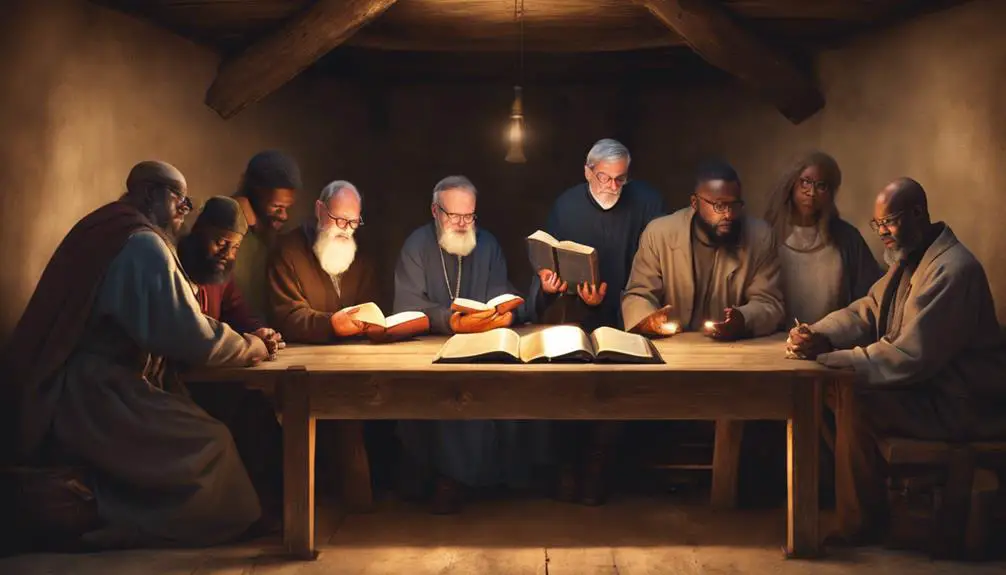Learn how Biblical teachings on cohabitation reveal complex views on modern relationships, inviting deeper exploration into ancient wisdom and today's norms.

Shacking up in the Bible
Wading through the waters of Biblical teachings on cohabitation is like navigating a labyrinth, with each turn presenting new interpretations and insights.
You might wonder how the ancient texts address modern concepts like 'shacking up,' especially considering the evolving nature of relationships and marriage.
The Bible offers a tapestry of guidance on sexual morality and partnerships, but understanding its stance requires peeling back layers of historical context and examining the nuances of marriage traditions within Scripture.
As you ponder the relevance of these teachings in today's society, remember that the conversation spans centuries, inviting you to explore how ancient wisdom intersects with contemporary norms.
Key Takeaways
- The Bible does not explicitly mention cohabitation, leaving interpretations to vary.
- Biblical marriage customs involved formal, legally recognized unions emphasizing sanctity.
- Figures like Ruth and Boaz demonstrate pre-marital cohabitation in a positive light.
- Modern religious views on cohabitation often view it as contrary to moral teachings.
Biblical Context of Cohabitation

While the Bible doesn't explicitly address the modern concept of cohabitation, it provides principles that have been interpreted to speak to the issue. You'll find that the societal norms captured in scripture, particularly those concerning property rights and dowry practices, offer a lens through which one might view the biblical perspective on relationships akin to cohabitation.
In ancient times, property rights were closely tied to family lineage and inheritance, a system that significantly influenced marital arrangements. These arrangements often included dowry practices, where a woman's family provided a dowry as part of the marriage contract. This practice not only secured the woman's financial future but also solidified alliances between families. The emphasis on marriage as a formal, contractual relationship involving property and dowries suggests a biblical preference for structured, legally recognized unions.
From this perspective, cohabitation, which lacks the formal recognition and contractual bindings of biblical-era marriages, diverges from the scriptural emphasis on legally and socially sanctioned relationships. This analysis doesn't outright condemn modern cohabitation but highlights the importance placed on formalized unions in biblical times, driven by considerations of property rights and the dowry system.
Marriage Traditions in Scripture

Marriage traditions within the biblical narrative reflect a complex interplay of cultural, religious, and legal factors that shaped societal norms and personal relationships. You'll find that these traditions, deeply rooted in ancient practices, offer a fascinating glimpse into the lives of those who lived thousands of years ago.
- Dowry customs played a pivotal role in marriages, serving not only as a bride-price but also as a form of protection for the woman. The dowry, often substantial, was a critical element in negotiations and symbolized the joining of two families rather than just two individuals.
- Wedding ceremonies varied greatly but typically involved several stages, including betrothal, preparation, and the actual celebration. These events weren't only religious but also social occasions, highlighting the importance of marriage within the community.
- Contracts were often established, detailing the obligations and rights of each party. These legal documents underscored the seriousness with which these societies approached marriage.
- Finally, the consummation of marriage marked the physical and spiritual union of the couple, a moment often accompanied by rituals and ceremonies to emphasize its significance.
In analyzing these traditions, it's evident that marriage in biblical times was a multifaceted institution, deeply interwoven with the fabric of ancient societies.
Sexual Morality and Relationships

In biblical times, societal norms and religious teachings significantly shaped perspectives on sexual morality and relationships. The value of virginity, especially among women, was highly emphasized, reflecting purity and moral integrity. This cultural and spiritual ethos underscored the importance of maintaining chastity until marriage, framing virginity as a virtue to be preserved. Such a stance wasn't merely social; it was deeply rooted in religious beliefs that underscored the sanctity of marital unions.
Moreover, the consequences of adultery were severe, illustrating the gravity with which sexual morality was regarded. Adultery disrupted the sacred bond of marriage, attracting social stigma and divine disapproval. The repercussions extended beyond the individuals involved, affecting societal harmony and spiritual alignment. The biblical narrative is replete with instances that highlight the devastating effects of adultery, serving as moral lessons for the community.
This emphasis on virginity and the stern view of adultery consequences underscored a broader principle of fidelity and purity within relationships. These values aimed to preserve the social fabric and ensure that relationships were built on trust, respect, and spiritual principles. In this context, sexual morality wasn't just a personal virtue but a communal asset, safeguarding societal well-being and spiritual integrity.
Interpretations by Modern Theologians

Modern theologians have diverged from traditional interpretations, critically re-evaluating biblical teachings on sexual morality and relationships through contemporary lenses. This shift has sparked significant theological debates, with scholars and religious leaders examining how scriptural directives should be applied in today's diverse societal contexts. Their analyses often emphasize the importance of cultural adaptation in understanding the Bible's messages.
Key points in these discussions include:
- Contextual Reading: Many argue that biblical texts on sexual relationships must be read within their historical and cultural contexts, suggesting that what was applicable then may not directly translate to modern settings.
- Hermeneutical Approaches: There's a growing emphasis on using hermeneutics, the science of interpretation, to uncover deeper meanings behind scripture that resonate with contemporary values and challenges.
- Ethical Considerations: Discussions often pivot around how biblical ethics can guide modern relationships, balancing respect for traditional values with the realities of current societal norms.
- Engagement with Modernity: Theologians are increasingly advocating for a dynamic engagement with scripture, allowing for interpretations that reflect present-day understandings of love, commitment, and sexuality.
These debates highlight the ongoing struggle to reconcile faith with cultural shifts, underscoring the complex interplay between historical texts and contemporary life.
Navigating Today's Cultural Norms

Confronting today's cultural norms, individuals and religious communities alike grapple with how to align their beliefs with rapidly evolving societal values regarding relationships and sexuality. This challenge necessitates a nuanced understanding of both scriptural teachings and the realities of contemporary life. Cultural adaptation becomes imperative as you navigate the delicate balance between maintaining traditional values and responding to societal pressures that advocate for more liberal interpretations of relationships outside of marriage.
You must analyze the historical context of biblical teachings, recognizing that these texts were written in vastly different cultural and societal settings. This analysis aids in discerning the core principles that can guide ethical behavior in today's context. Societal pressures to conform to modern norms of sexuality and cohabitation can be intense, making it essential for you to critically evaluate which aspects of contemporary culture can be embraced without compromising your spiritual integrity.
Engaging in open, respectful dialogues within your community helps in collectively navigating these complex issues. By doing so, you promote a deeper understanding and a more meaningful integration of faith into daily life amidst the ever-changing landscape of cultural norms.
Frequently Asked Questions
How Did Early Christian Communities React to Couples Living Together Before Marriage, Outside of Theological Teachings?
You'd find early Christian communities had unique reactions to couples living together before marriage, beyond just theological teachings. Community norms played a significant role; they often dictated behavior and societal acceptance.
Legal consequences, though varying widely, could include fines or public censure, reflecting the era's attempt to regulate personal relationships through both community standards and law. These aspects underscore how early Christians navigated the balance between personal choices and communal expectations.
Were There Any Specific Rituals or Blessings for Couples Cohabitating in Biblical Times That Are Not Commonly Discussed Today?
Interestingly, you won't find specific rituals or blessings for cohabiting couples in biblical records, mirroring how a ship sails without a compass in uncharted waters. This absence highlights the focus on marital symbolism and covenant rituals within a formalized union, rather than informal arrangements.
Traditionally, these covenant rituals served as a cornerstone, reflecting commitment and societal recognition, which cohabitation, lacking structured ceremonies, didn't encapsulate in the same way.
How Did the Concept of Cohabitation Evolve in the Context of Biblical History, Especially During Periods Not Directly Addressed in the Scriptures?
You're exploring how cohabitation evolved when the Bible doesn't specifically address certain periods.
It's crucial to understand that marriage contracts and social norms shaped these practices significantly.
Historical analyses suggest that as societies evolved, so did the perception of cohabitation, influenced by changing social norms and the formalization of marriage contracts.
This evolution reflects broader societal shifts, indicating that cohabitation's acceptance and regulation were always in flux, adapting to contemporary values and laws.
Can Archaeological or Historical Evidence Shed Light on the Living Arrangements of Couples in Ancient Biblical Societies Beyond What Is Described in Religious Texts?
Yes, you're on the right track. Delving into the 'stone age' of domestic architecture and marriage contracts can indeed illuminate the living arrangements of ancient couples beyond scriptural descriptions.
What Are the Psychological and Social Implications of Cohabitation Before Marriage, as Understood From a Biblical Perspective, That Might Not Be Covered by Modern Theological Interpretations?
You're exploring how living together before marriage influences couples today, beyond traditional theological views. Modern compatibility and cultural adaptation play key roles in this analysis.
The psychological and social implications include how these arrangements affect relationship dynamics, commitment levels, and societal perceptions.
It's essential to consider how evolving cultural norms and the quest for compatibility influence these outcomes, diverging from biblical interpretations that don't fully address these contemporary shifts.
Conclusion
Navigating the labyrinth of cohabitation within a biblical context involves exploring ancient marriage traditions, scrutinizing sexual morality, and dissecting modern theologians' interpretations.
In a world where cultural norms are as shifting as sand in a hurricane, it's crucial to critically evaluate these perspectives against your values and beliefs.
Remember, while scripture offers a foundational compass, interpreting its guidance in today's context requires wisdom, discernment, and perhaps a dash of divine inspiration.



Sign up